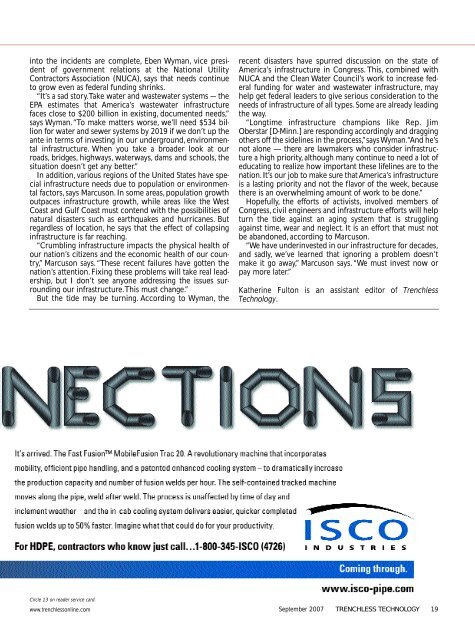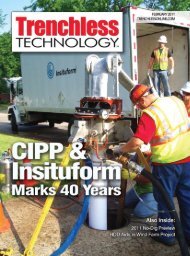Author: Professor, Dr. Dietrich Stein - TrenchlessOnline
Author: Professor, Dr. Dietrich Stein - TrenchlessOnline
Author: Professor, Dr. Dietrich Stein - TrenchlessOnline
You also want an ePaper? Increase the reach of your titles
YUMPU automatically turns print PDFs into web optimized ePapers that Google loves.
into the incidents are complete, Eben Wyman, vice president<br />
of government relations at the National Utility<br />
Contractors Association (NUCA), says that needs continue<br />
to grow even as federal funding shrinks.<br />
“It’s a sad story.Take water and wastewater systems — the<br />
EPA estimates that America’s wastewater infrastructure<br />
faces close to $200 billion in existing, documented needs,”<br />
says Wyman.“To make matters worse, we’ll need $534 billion<br />
for water and sewer systems by 2019 if we don’t up the<br />
ante in terms of investing in our underground, environmental<br />
infrastructure. When you take a broader look at our<br />
roads, bridges, highways, waterways, dams and schools, the<br />
situation doesn’t get any better.”<br />
In addition, various regions of the United States have special<br />
infrastructure needs due to population or environmental<br />
factors, says Marcuson. In some areas, population growth<br />
outpaces infrastructure growth, while areas like the West<br />
Coast and Gulf Coast must contend with the possibilities of<br />
natural disasters such as earthquakes and hurricanes. But<br />
regardless of location, he says that the effect of collapsing<br />
infrastructure is far reaching.<br />
“Crumbling infrastructure impacts the physical health of<br />
our nation’s citizens and the economic health of our country,”<br />
Marcuson says.“These recent failures have gotten the<br />
nation’s attention. Fixing these problems will take real leadership,<br />
but I don’t see anyone addressing the issues surrounding<br />
our infrastructure.This must change.”<br />
But the tide may be turning. According to Wyman, the<br />
Circle 13 on reader service card.<br />
www.trenchlessonline.com<br />
recent disasters have spurred discussion on the state of<br />
America’s infrastructure in Congress. This, combined with<br />
NUCA and the Clean Water Council’s work to increase federal<br />
funding for water and wastewater infrastructure, may<br />
help get federal leaders to give serious consideration to the<br />
needs of infrastructure of all types.Some are already leading<br />
the way.<br />
“Longtime infrastructure champions like Rep. Jim<br />
Oberstar [D-Minn.] are responding accordingly and dragging<br />
others off the sidelines in the process,”says Wyman.“And he’s<br />
not alone — there are lawmakers who consider infrastructure<br />
a high priority, although many continue to need a lot of<br />
educating to realize how important these lifelines are to the<br />
nation.It’s our job to make sure that America’s infrastructure<br />
is a lasting priority and not the flavor of the week, because<br />
there is an overwhelming amount of work to be done.”<br />
Hopefully, the efforts of activists, involved members of<br />
Congress,civil engineers and infrastructure efforts will help<br />
turn the tide against an aging system that is struggling<br />
against time, wear and neglect. It is an effort that must not<br />
be abandoned, according to Marcuson.<br />
“We have underinvested in our infrastructure for decades,<br />
and sadly, we’ve learned that ignoring a problem doesn’t<br />
make it go away,” Marcuson says.“We must invest now or<br />
pay more later.”<br />
Katherine Fulton is an assistant editor of Trenchless<br />
Technology.<br />
September 2007 TRENCHLESS TECHNOLOGY 19








